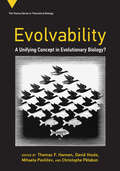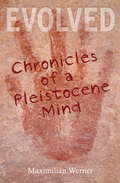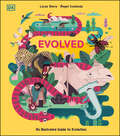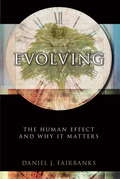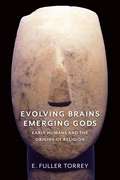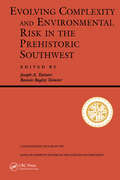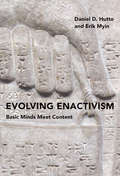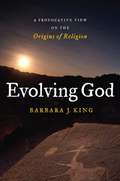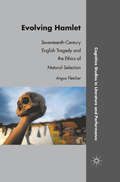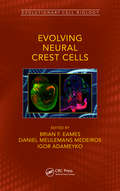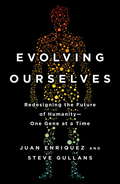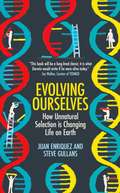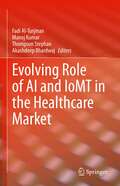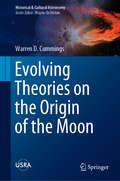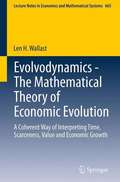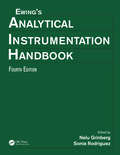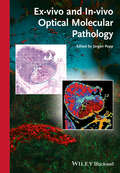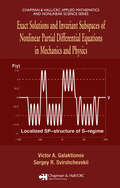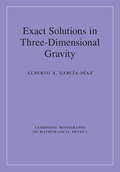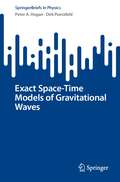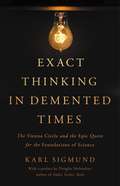- Table View
- List View
Evolvability: A Unifying Concept in Evolutionary Biology?
by Thomas F. Hansen, David Houle, Mihaela Pavličev, and Christophe PélabonEssays on evolvability from the perspectives of quantitative and population genetics, evolutionary developmental biology, systems biology, macroevolution, and the philosophy of science.Evolvability—the capability of organisms to evolve—wasn&’t recognized as a fundamental concept in evolutionary theory until 1990. Though there is still some debate as to whether it represents a truly new concept, the essays in this volume emphasize its value in enabling new research programs and facilitating communication among the major disciplines in evolutionary biology. The contributors, many of whom were instrumental in the development of the concept of evolvability, synthesize what we have learned about it over the past thirty years. They focus on the historical and philosophical contexts that influenced the emergence of the concept and suggest ways to develop a common language and theory to drive further evolvability research. The essays, drawn from a workshop on evolvability hosted in 2019–2020 by the Center of Advanced Study at the Norwegian Academy of Science and Letters, in Oslo, provide scientific and historical background on evolvability. The contributors represent different disciplines of evolutionary biology, including quantitative and population genetics, evolutionary developmental biology, systems biology and macroevolution, as well as the philosophy of science. This pl[urality of approaches allows researchers in disciplines as diverse as developmental biology, molecular biology, and systems biology to communicate with those working in mainstream evolutionary biology. The contributors also discuss key questions at the forefront of research on evolvability.Contributors:J. David Aponte, W. Scott Armbruster, Geir H. Bolstad, Salomé Bourg, Ingo Brigandt, Anne Calof, James M. Cheverud, Josselin Clo, Frietson Galis, Mark Grabowski, Rebecca Green, Benedikt Hallgrímsson, Thomas F. Hansen, Agnes Holstad, David Houle, David Jablonski, Arthur Lander, Arnaud LeRouzic, Alan C. Love, Ralph Marcucio, Michael B. Morrissey, Laura Nuño de la Rosa, Øystein H. Opedal, Mihaela Pavličev, Christophe Pélabon, Jane M. Reid, Heather Richbourg, Jacqueline L. Sztepanacz, Masahito Tsuboi, Cristina Villegas, Marta Vidal-García, Kjetil L. Voje, Andreas Wagner, Günter P. Wagner, Nathan M. Young
Evolved
by Maximilian Werner John AlcockFrom which side of the bed you sleep on to where to play a backyard game of hide-and-go-seek, Maximilian Werner examines elements of everyday behavior through the eye-opening lens of evolutionary theory in this memoir-infused nonfiction. Werner applies an intriguingly fresh take to seldom-explored habits of humans and animals alike, guiding readers backward in time to the Pleistocene."Werner's prose is compelling, his natural history is thoroughly engaging, and his line of curious inquiry is an admirable attempt to better understand humanity and its changing relationship with the external world."-Publishers Weekly"This book provides an entry in to the great epic of evolution in a way that makes it both accessible and inspiring. This is no small accomplishment and we are all indebted to Maximilian Werner."-Mary Evelyn Tucker, co- author, Journey of the Universe"Join this sensitive and perceptive naturalist as he explores his yard and nearby caves and mountains, carefully observing the activities of myriad life forms, and then reflecting insightfully on the evolutionary story we share with them. Learn from him how to feel completely at home in the world."-Loyal Rue, author of Religion is Not about God: How Spiritual Traditions Nurture Our Biological Nature and What to Expect When They Fail"Werner's book, thought-provoking and emotionally satisfying, takes us on a journey, a journey that ultimately urges each one of us to get up, go outside and hunt around the edges of our homes for the mysteries that await."-Sylvia Torti, author of The Scorpion's Tail
Evolved: An Illustrated Guide to Evolution
by Lucas RieraFollow the story of evolution! The illustrated children&’s book is a beautiful introduction to the evolution of species over millions of years.What&’s made animals survive and naturally go extinct? Why are fish scaled? Why do birds have wings? Find out about the changing animal anatomy discoveries made by Swedish zoologist Charles Linneas.Animals and evolution are fascinating subjects to teach little minds. Discover the ways that animals have adapted to survive and the amazing reasons behind these adaptations. The illustrated guide includes: • Beautiful artwork, perfect for fans of Owen Davey. • Many different animal features (like eyes, scales, claws, hair and many more), as well as feature spreads on topics like fast evolution. • Highly accessible text about a key school subject. Kids age 7 and older will be delighted by the scientific facts in this wildlife book. It&’s filled with incredible bits of information that spark a deep curiosity in the natural world, evolution and the animal kingdom. The book highlights that evolution is an ongoing process, and allows kids to look at the world around them and notice the continuing evolution of species. Evolved also features more in-depth explanations of animal body parts, how they work and how they&’re different from other species. Children will understand how evolution made certain elements of the natural world unnecessary, and others integral to survival. Explanations of Charles Linneas&’ classification system of all living things are included and give kids, adults and educators a fantastic reference to the magnificent living world.
Evolving
by Daniel J. FairbanksThis persuasive, elegantly written book argues that understanding evolution has never mattered more in human history. The author not only uses evidence from archaeology, geography, anatomy, biochemistry, radiometric dating, cell biology, chromosomes, and DNA to establish the inescapable conclusion that we evolved and are still evolving, he also explains in detail how health, food production, and human impact on the environment are dependent on our knowledge of evolution. This is essential reading for gaining a fuller appreciation of who we are, our place in the great expanse of life, and the importance of our actions.
Evolving Animals
by Wallace Arthur Stephen ArthurWhat do we know about animal evolution in the early twenty-first century? How much more do we know today than Darwin did? What are the most exciting discoveries that have been made in the last few decades? Covering all the main animal groups, from jellyfish to mammals, this book considers all of these questions and more. Its 30 short chapters, each written in a conversational, nontechnical style and accompanied by numerous original illustrations, deal equally with the pattern and the process of evolution - with both evolutionary trees and evolutionary mechanisms. They cover diverse evolutionary themes, including: the animal toolkit, natural selection, embryos and larvae, animal consciousness, fossils, human evolution, and even the possibility of animal life existing elsewhere than on Earth. This unique text will make an excellent introduction for undergraduates and others with an interest in the subject.
Evolving Brains, Emerging Gods: Early Humans and the Origins of Religion
by E. Fuller TorreyReligions and mythologies from around the world teach that God or gods created humans. Atheist, humanist, and materialist critics, meanwhile, have attempted to turn theology on its head, claiming that religion is a human invention. In this book, E. Fuller Torrey draws on cutting-edge neuroscience research to propose a startling answer to the ultimate question. Evolving Brains, Emerging Gods locates the origin of gods within the human brain, arguing that religious belief is a by-product of evolution.Based on an idea originally proposed by Charles Darwin, Torrey marshals evidence that the emergence of gods was an incidental consequence of several evolutionary factors. Using data ranging from ancient skulls and artifacts to brain imaging, primatology, and child development studies, this book traces how new cognitive abilities gave rise to new behaviors. For instance, autobiographical memory, the ability to project ourselves backward and forward in time, gave Homo sapiens a competitive advantage. However, it also led to comprehension of mortality, spurring belief in an alternative to death. Torrey details the neurobiological sequence that explains why the gods appeared when they did, connecting archaeological findings including clothing, art, farming, and urbanization to cognitive developments. This book does not dismiss belief but rather presents religious belief as an inevitable outcome of brain evolution. Providing clear and accessible explanations of evolutionary neuroscience, Evolving Brains, Emerging Gods will shed new light on the mechanics of our deepest mysteries.
Evolving Complexity And Environmental Risk In The Prehistoric Southwest (Santa Fe Institute Studies In The Sciences Of C... Ser.)
by Joseph A. TainterThis book explores how and why prehistoric Southwestern societies changed in complexity, and offers important new perspectives on evolution of culture. It discusses the factors that made prehistoric Southwesterners vulnerable to an arid environment, and their strategies to lessen risk and stress.
Evolving Enactivism: Basic Minds Meet Content (The\mit Press Ser.)
by Daniel D. Hutto Erik MyinAn extended argument that cognitive phenomena—perceiving, imagining, remembering—can be best explained in terms of an interface between contentless and content-involving forms of cognition.Evolving Enactivism argues that cognitive phenomena—perceiving, imagining, remembering—can be best explained in terms of an interface between contentless and content-involving forms of cognition. Building on their earlier book Radicalizing Enactivism, which proposes that there can be forms of cognition without content, Daniel Hutto and Erik Myin demonstrate the unique explanatory advantages of recognizing that only some forms of cognition have content while others—the most elementary ones—do not. They offer an account of the mind in duplex terms, proposing a complex vision of mentality in which these basic contentless forms of cognition interact with content-involving ones. Hutto and Myin argue that the most basic forms of cognition do not, contrary to a currently popular account of cognition, involve picking up and processing information that is then used, reused, stored, and represented in the brain. Rather, basic cognition is contentless—fundamentally interactive, dynamic, and relational. In advancing the case for a radically enactive account of cognition, Hutto and Myin propose crucial adjustments to our concept of cognition and offer theoretical support for their revolutionary rethinking, emphasizing its capacity to explain basic minds in naturalistic terms. They demonstrate the explanatory power of the duplex vision of cognition, showing how it offers powerful means for understanding quintessential cognitive phenomena without introducing scientifically intractable mysteries into the mix.
Evolving God
by Barbara J. KingThis cutting-edge book—with echoes of both Jane Goodall and Joseph Campbell—adds a fascinating new dimension to the debate about the origins of religion. The study of evolution has uncovered invaluable information about many aspects of human behavior and culture, from the physiology of our bodies and brains to the development of hunting, technology, and social groups. But an understanding of the intangibles of human experience, especially religion, lags far behind. Attempts to discover the source of ...
Evolving Hamlet
by Angus FletcherUsing Hamlet and a number of other popular and influential seventeenth-century tragedies as case-studies, this book shows how aesthetic experience can help organize the biological functions of our brains into adaptive social networks.
Evolving Neural Crest Cells (Evolutionary Cell Biology)
by Brian F. Eames Daniel Meulemans Medeiros Igor AdameykoVertebrates possess lineage-specific characteristics. These include paired anterior sense organs and a robust, modular head skeleton built of cellular cartilage and bone. All of these structures are derived, at least partly, from an embryonic tissue unique vertebrates - the neural crest. The evolutionary history of the neural crest, and neural crest cells, has been difficult to reconstruct. This volume will use a comparative approach to survey the development of the neural crest in vertebrates, and neural crest-like cells, across the metazoa. This information will be used to reveal neural crest evolution and identify the genomic, genetic, and gene-regulatory changes that drove them. Key selling features: Summarizes the data regarding neural crest cells and nerural crest derivatives Uses a broad-based comparative approach Suggests hypothesis that the origin of neural crest cells involved the novel co-activation of ancient metazoan gene programs in neural border cells Illustrates how the emergences of neural crest made possible the diversification of vertebrate heads
Evolving Ourselves
by Juan Enriquez Steve Gullans"We are the primary drivers of change. We will directly and indirectly determine what lives, what dies, where, and when. We are in a different phase of evolution; the future of life is now in our hands."Why are rates of conditions like autism, asthma, obesity, and allergies exploding at an unprecedented pace? Why are humans living longer, getting smarter, and having far fewer kids? How might your lifestyle affect your unborn children and grandchildren? If Darwin were alive today, how would he explain this new world? Could our progeny eventually become a different species--or several?In Evolving Ourselves, futurist Juan Enriquez and scientist Steve Gullans conduct a sweeping tour of how humans are changing the course of evolution--sometimes intentionally, sometimes not. For example:Globally, rates of obesity in humans nearly doubled between 1980 and 2014. What's more, there's evidence that other species, from pasture-fed horses to lab animals to house cats, are also getting fatter.As reported by U.S. government agencies, the rate of autism rose by 131 percent from 2001 to 2010, an increase that cannot be attributed simply to increases in diagnosis rates.Three hundred years ago, almost no one with a serious nut allergy lived long enough to reproduce. Today, despite an environment in which food allergies have increased by 50 percent in just over a decade, 17 million Americans who suffer from food allergies survive, thrive, and pass their genes and behaviors on to the next generation.In the pre-Twinkie era, early humans had quite healthy mouths. As we began cooking, bathing, and using antibiotics, the bacteria in our bodies changed dramatically and became far less diverse. Today the consequences are evident not only in our teeth but throughout our bodies and minds.Though these harbingers of change are deeply unsettling, the authors argue that we are also in an epoch of tremendous opportunity. New advances in biotechnology help us mitigate the cruel forces of natural selection, from saving prematurely born babies to gene therapies for sickle cell anemia and other conditions. As technology enables us to take control of our genes, we will be able to alter our own species and many others--a good thing, given that our eventual survival will require space travel and colonization, enabled by a fundamental redesign of our bodies. Future humans could become great caretakers of the planet, as well as a more diverse, more resilient, gentler, and more intelligent species--but only if we make the right choices now. Intelligent, provocative, and optimistic, Evolving Ourselves is the ultimate guide to the next phase of life on Earth.
Evolving Ourselves: How Unnatural Selection and Nonrandom Mutation are Changing Life on Earth
by Juan Enriquez Steve Gullans"We are the primary drivers of change. We will directly and indirectly determine what lives, what dies, where, and when. We are in a different phase of evolution; the future of life is now in our hands."Why are rates of conditions like autism, asthma, obesity, and allergies exploding at an unprecedented pace? Why are humans living longer, getting smarter, and having far fewer kids? How might your lifestyle affect your unborn children and grandchildren? How will gene-editing technologies like CRISPR steer the course of human evolution? If Darwin were alive today, how would he explain this new world? Could our progeny eventually become a different species--or several?In Evolving Ourselves, futurist Juan Enriquez and scientist Steve Gullans conduct a sweeping tour of how humans are changing the course of evolution--sometimes intentionally, sometimes not. For example: * Globally, rates of obesity in humans nearly doubled between 1980 and 2014. What's more, there's evidence that other species, from pasture-fed horses to lab animals to house cats, are also getting fatter. * As reported by U.S. government agencies, the rate of autism rose by 131 percent from 2001 to 2010, an increase that cannot be attributed simply to increases in diagnosis rates. * Three hundred years ago, almost no one with a serious nut allergy lived long enough to reproduce. Today, despite an environment in which food allergies have increased by 50 percent in just over a decade, 17 million Americans who suffer from food allergies survive, thrive, and pass their genes and behaviors on to the next generation. * In the pre-Twinkie era, early humans had quite healthy mouths. As we began cooking, bathing, and using antibiotics, the bacteria in our bodies changed dramatically and became far less diverse. Today the consequences are evident not only in our teeth but throughout our bodies and minds. Though these harbingers of change are deeply unsettling, the authors argue that we are also in an epoch of tremendous opportunity. New advances in biotechnology help us mitigate the cruel forces of natural selection, from saving prematurely born babies to gene therapies for sickle cell anemia and other conditions. As technology like CRISPR enables us to take control of our genes, we will be able to alter our own species and many others--a good thing, given that our eventual survival will require space travel and colonization, enabled by a fundamental redesign of our bodies.Future humans could become great caretakers of the planet, as well as a more diverse, more resilient, gentler, and more intelligent species--but only if we make the right choices now.Intelligent, provocative, and optimistic, Evolving Ourselves is the ultimate guide to the next phase of life on Earth.From the Hardcover edition.
Evolving Ourselves: How Unnatural Selection is Changing Life on Earth
by Juan Enriquez Steve GullansIf Darwin were alive today, he would likely recognize that technology has evolved so far, and so fast, that the origin, evolution, and future of life itself is no longer just driven by natural selection and random mutation. Why are genetic conditions like autism, asthma, and allergies on the rise at unprecedented, biologically impossible speeds? What traits does our world select for, and what does that mean for us? Will our children be a different species?Today's humans have altered the nature of our world so much, and developed such profound capabilities for re-crafting our bodies and environment, that random mutation and natural selection are no longer the primary determinants of which species survives and how they change over time. The nature of the evolution of our world is now increasingly defined and driven by: Un-Natural Selection-- where the traits being selected for have little to nothing to do with our ability to survive and thrive--and Non-Random Mutation-- in which drastic changes to our environment wreak havoc on what gene are expressed and passed down.Evolving Ourselves is the story of how our massive human perturbation and, increasingly, our specific designs and desires are altering life on Earth. It is a chronicle of where our remarkable new capabilities for altering our bodies, other living creatures, and our environment are taking us in the near term, and introduces the possibility that we might cause our own extinction in the long run.
Evolving Role of AI and IoMT in the Healthcare Market
by Manoj Kumar Fadi Al-Turjman Akashdeep Bhardwaj Thompson StephanThis book is a proficient guide to understanding artificial intelligence (IoT) and the Internet of Medical Things (IoMT) in healthcare. The book provides a comprehensive study on the applications of AI and IoT in various medical domains. The book shows how the implementation of innovative solutions in healthcare is beneficial, and IoT, together with AI, are strong drivers of the digital transformation regardless of what field the technologies are applied in. Therefore, this book provides a high level of understanding with the emerging technologies on the Internet of Things, wearable devices, and AI in IoMT, which offers the potential to acquire and process a tremendous amount of data from the physical world.
Evolving Theories on the Origin of the Moon: Studies On The Origin Of The Moon (Historical & Cultural Astronomy)
by Warren D. CummingsThis book follows the development of research on the origin of the Moon from the late 18th century to the present. By gathering together the major texts, papers, and events of the time, it provides a thorough chronicle of the paradigmatic shift in planetary science that arose from the notion that the Earth-Moon system was formed from two colliding planetary bodies.The book covers pre-Apollo ideas, the conceptual evolution during and subsequent to the Apollo explorations of the Moon, and the development of the Earth-Moon system consensus.A plethora of excerpts from key publications are included to demonstrate the shift in scientific focus over the centuries.Through its comprehensive review of lunar science research and literature, this book shows how new technologies and discoveries catalyzed the community and revolutionized our understanding of the Moon’s formation.
Evolvodynamics - The Mathematical Theory of Economic Evolution
by Len H. WallastDissatisfied with the flaws of orthodox economics, the author proposes to base economic theory on the three principles of Darwinian evolution (variation, inheritance, selection). Pursuing a suggestion of E.T. Jaynes of 1991, the innovation is in treating economic behavior as chance events of selection. This involves abandoning the methods of mainstream economics and to apply instead the methods by which Claude E. Shannon analyzed information transport over a stationary channel. As economic processes are non-stationary, the author clarifies first how the Shannon-system must be reshaped in a system capable to describe economic evolution mathematically. As economic processes are non-stationary, the author first clarifies how the Shannon system must be reshaped into one capable of describing economic evolutions mathematically. Deriving the universal relations between input, output, the economic growth rate, inflation and money flow involves applying differential sets of selection, Venn diagrams, bitpulses as units of selection and the probability distributions of bitpulses. This is a thought-provocative and highly informative book of which the explanatory power goes far beyond that of traditional economics. It should be on the readers list of everyone concerned with the weal and woe of economic theorizing.
Ewing's Analytical Instrumentation Handbook, Fourth Edition
by Sonia Rodriguez Nelu GrinbergThis handbook is a guide for workers in analytical chemistry who need a starting place for information about a specific instrumental technique. It gives a basic introduction to the techniques and provides leading references on the theory and methodology for an instrumental technique. This edition thoroughly expands and updates the chapters to include concepts, applications, and key references from recent literature. It also contains a new chapter on process analytical technology.
Ex-vivo and In-vivo Optical Molecular Pathology
by Jürgen PoppThe result of a unique collaboration between clinicians and physicists, this book provides an unparalleled overview of a new generation of diagnostic tools in clinical pathology. The introductory three chapters cover the present status and limitations of currently used methods, followed by an outline of promising novel spectroscopy-based technologies either under development or recently available on the market. The input from both physicists developing these new methods as well as routine clinicians familiar with practical aspects and medical relevance guarantees that this practical work is a valuable asset for a wide audience, including technical personnel and decision makers in treatment centers, experts working in companies developing diagnostic devices, and clinicians specializing in advanced diagnostic methods. Since basic researchers are increasingly adopting novel diagnostic tools developed for human use as well, this will also be of interest for biomedical research institutions with large animal facilities.
Exact Controllability and Stabilization of the Wave Equation (UNITEXT #162)
by Enrique ZuazuaThis comprehensive monograph illustrates the intricate realm of controllability and stabilization of wave phenomena. Authored by an expert in the field, this book integrates J. L. Lion's renowned HUM method, multiplier techniques, and the construction of Lyapunov functionals. Through meticulous analysis and practical applications, this book provides invaluable insights for researchers seeking to navigate the expansive domain of wave-like equations and their control. Whether you are a seasoned mathematician or a newcomer to the field, this book serves as an indispensable guide, offering a thorough introduction and essential tools for understanding and controlling wave phenomena.
Exact Solutions and Invariant Subspaces of Nonlinear Partial Differential Equations in Mechanics and Physics
by Victor A. Galaktionov Sergey R. SvirshchevskiiExact Solutions and Invariant Subspaces of Nonlinear Partial Differential Equations in Mechanics and Physics is the first book to provide a systematic construction of exact solutions via linear invariant subspaces for nonlinear differential operators. Acting as a guide to nonlinear evolution equations and models from physics and mechanics, the book
Exact Solutions in Three-Dimensional Gravity (Cambridge Monographs on Mathematical Physics)
by Alberto A. García-DíazA self-contained text, systematically presenting the determination and classification of exact solutions in three-dimensional Einstein gravity. This book explores the theoretical framework and general physical and geometrical characteristics of each class of solutions, and includes information on the researchers responsible for their discovery. Beginning with the physical character of the solutions, these are identified and ordered on the basis of their geometrical invariant properties, symmetries, and algebraic classifications, or from the standpoint of their physical nature, for example electrodynamic fields, fluid, scalar field, or dilaton. Consequently, this text serves as a thorough catalogue on 2+1 exact solutions to the Einstein equations coupled to matter and fields, and on vacuum solutions of topologically massive gravity with a cosmological constant. The solutions are also examined from different perspectives, enabling a conceptual bridge between exact solutions of three- and four-dimensional gravities, and therefore providing graduates and researchers with an invaluable resource on this important topic in gravitational physics. The first book in the field of 2+1 gravity to examine solutions of physical interest. All the physical and mathematical concepts required are explained in the text, enabling readers to gain a complete understanding of the complexities of the field. Includes a complete review of vacuum solutions of topologically massive gravity with a cosmological constant, which shows the algebraic classification of space times at work.
Exact Space-Time Models of Gravitational Waves (SpringerBriefs in Physics)
by Dirk Puetzfeld Peter A. HoganThe book is about exact space-time models of the gravitational fields produced by gravitational radiation. The authors’ extensive work in the field is reviewed in order to stimulate the study of such models, that have been known for a long time, and to highlight interesting physical aspects of the existing models in some novel detail. There is an underlying simplicity to the gravitational radiation studied in this book. Apart from the basic assumption that the radiation has clearly identifiable wave fronts, the gravitational waves studied are directly analogous to electromagnetic waves. The book is meant for advanced students and researchers who have a knowledge of general relativity sufficient to carry out research in the field.
Exact Space-Times in Einstein's General Relativity
by Jerry B. Griffiths Ji Í PodolskýEinstein's theory of general relativity is a theory of gravity and, as in the earlier Newtonian theory, much can be learnt about the character of gravitation and its effects by investigating particular idealised examples. This book, first published in 2009, describes the basic solutions of Einstein's equations with a particular emphasis on what they mean, both geometrically and physically. Concepts such as big bang and big crunch-types of singularities, different kinds of horizons and gravitational waves, are described in the context of the particular space-times in which they naturally arise. These notions are initially introduced using the most simple and symmetric cases. Various important coordinate forms of each solution are presented, thus enabling the global structure of the corresponding space-time and its other properties to be analysed. The book is an invaluable resource both for graduate students and academic researchers working in gravitational physics.
Exact Thinking in Demented Times: The Vienna Circle and the Epic Quest for the Foundations of Science
by Douglas Hofstadter Karl SigmundA dazzling group biography of the early twentieth-century thinkers who transformed the way the world thought about math and scienceInspired by Albert Einstein's theory of relativity and Bertrand Russell and David Hilbert's pursuit of the fundamental rules of mathematics, some of the most brilliant minds of the generation came together in post-World War I Vienna to present the latest theories in mathematics, science, and philosophy and to build a strong foundation for scientific investigation. Composed of such luminaries as Kurt Gödel and Rudolf Carnap, and stimulated by the works of Ludwig Wittgenstein and Karl Popper, the Vienna Circle left an indelible mark on science.Exact Thinking in Demented Times tells the often outrageous, sometimes tragic, and never boring stories of the men who transformed scientific thought. A revealing work of history, this landmark book pays tribute to those who dared to reinvent knowledge from the ground up.
